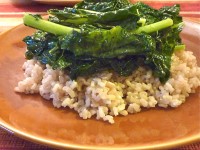
Bring on the pungent and deliciously bitter flavours! Sauteed kale with garlic and ginger.
by Valerie Love
Have you ever wondered why some people can eat heaps and stay slender, while others can eat less and still gain weight? Why in the same room, some people will feel cold and others complain of heat? Why some people respond to a difficult situation with anger or fear, while others stay calm and collected?
Ayurveda can help answer these questions.
“Ayurveda” is Sanskrit for “knowledge (or science) of life,” and provides a framework for lifestyle and medicine aligned with the laws of nature. We can use ayurvedic teachings to pacify imbalances in our lifestyles, eating habits, and behaviours in order to promote optimal health. Although it developed 5,000 years ago, Ayurveda’s wisdom is timeless, and offers insights into well-being that remain surprisingly relevant today.
Ayurveda teaches that we are all comprised of five elements: earth (structure/form), water (chemical energy), air (movement), ether (space), and fire (transformation). Each of us has different amounts of these five elements within us, which comprise our constitution, or dosha. When our bodies are in harmony with the proportions of these elements that we were born with, we are in balance. However if over time, one or more of these elements begins to dominate within us, imbalances arise which can lead to mental and physical issues in the body.
The Three Doshas
There are three doshas in ayurveda: vata, pitta, and kapha. If the elements of air and ether are strongest within us, we have a vata dosha. If the elements of fire and water are the strongest, then that creates a pitta dosha. Those for whom water and earth dominate have a kapha constitution in the body and mind.
Although we all have aspects of all five elements and each of the three doshas within us that together create our prakriti, or nature, rarely are we an even mix. Resources to determine your primary dosha are available online, and I’ve listed some at the end of this article.
However, as many of us have more than one predominant dosha, working directly with an ayurvedic practitioner is the best way to determine your constitution. Understanding your dosha and the qualities associated with it can provide insight into your body’s responses to the conditions around us.
Being a ginger, my primary ayurvedic dosha is relatively easy to identify. With my red hair, pale skin, and medium build, I have the classic physical characteristics of a pitta dosha. Personality-wise, the signs point to pitta as well: intense, determined, and with a strong desire for things to be done well (and generally my way!). My passion for food is a pitta trait as well— pittas are notorious for having strong appetites and never skipping a meal.
However, at the time in my life that I first began studying ayurveda, when I ticked the boxes on the list, most of my answers were in the vata column. As my teacher helped me to understand, this didn’t mean that my primary dosha was vata. Instead, it showed an imbalance in my system. Vata had come to dominate over my original constitution, which was in fact not solely pitta but instead pitta-kapha, meaning that I have strong pitta and kapha qualities.
So why did my checklist show vata?
Vata is said to be the leader of the doshas, and the one most easily to become imbalanced. Vata embodies the energy of movement. Those with a primary vata dosha tend to be naturally slender, with dry skin and hair, and often feel cold. Personality-wise, vatas tend to be more unpredictable than the other doshas, and love excitement and constant change.
In my case, the stress and long hours from my job and my attempts to do 15 things at once on any given day, had built up over several years and left me feeling scattered, anxious, overly fatigued, but yet unable to sleep at night because my mind just wouldn’t turn off at the end of the day. All classic signs of a vata imbalance.
When pitta becomes out of balance in the body, the characteristic intensity of pitta is magnified, and the result is generally anger and frustration. Physical signs of pitta imbalance include indigestion and heartburn, which is one of the reasons why those with pitta doshas are advised to limit their intake of spicy foods.
Those with a predominately kapha dosha tend to be physically larger than the other doshas, with a solid build, steady temperament, dark hair, and large, shining eyes. Kaphas have greater endurance than other doshas, and tend to have a nurturing, selfless, community-oriented personality. When kapha becomes out of balance, this can result in lethargy, depression, or weight gain.
Ayurveda and Food
Food holds a significant role in the teachings of ayurveda. Both the foods that we eat, and the manner in which we eat, can create imbalances in the body. Over time, these imbalances can lead to digestive problems and health issues more broadly. A specific food can compliment one dosha and aggravate another.
As Scott Blossom, a yoga teacher and ayurvedic specialist based in San Francisco states:
“Eating is the most important activity we engage in for determining the health of the body and the mind. Eating nourishes the tissues, which in turn nourish the mind and emotions. It is essential to bring positive attention and reverence to the process of food selection, preparation, consumption, and digestion.”
In addition to the three gunas, which I discussed in my previous column, ayurveda teaches that there are 6 rasas, or tastes, to the foods that we eat. The first three tastes are probably the most familiar (and over-consumed in Western cultures), but there are benefits to incorporating all six flavours into each meal:
- Sweet
- Sour
- Salty
- Bitter
- Pungent
- Astringent
Vatas benefit from sweet, sour and salty flavours more than the other doshas do. But because bitter, pungent, and astringent tastes have beneficial effects on the body, and tend to be under-represented in most meals, it’s important to try to include them, rather than focusing on just the simpler tastes of sweet and salty.
Obviously, sugary foods fall into the category of sweet tastes, but so do dairy products such as milk and butter, wheat, rice, barley, many fruits, and vegetables such as beetroot, potatoes and carrots. Sweet foods build tissues in the body and calm nerves, and this is part of the reason why we turn to sweet comfort foods during times of stress. Sweet foods offer the greatest benefit for thin-framed vata individuals, but pitta can also be soothed by a moderate amount of sweet foods. Kapha, on the other hand, is aggravated by sweet tastes and will be better served by other flavours.
Sour flavours are found in citrus fruits, yoghurt, cheese, and fermented items including soy sauce, wine, tofu, and vinegar. Sour tastes are warming to the body, and stimulate the digestive and circulatory systems. Sour tastes benefit vata, but in excess can create indigestion for other doshas.
Salty tastes, like sweet tastes, are often over-consumed, but good sources include miso, sea vegetables, and sea salt. Salty flavours are most beneficial for vata (again, in moderation), as the other doshas are less well-suited to them.
Bitter tastes are light, cooling, and dry, and can be detoxifying for the body. Examples of bitter foods include spinach, kale, eggplant, turmeric, fenugreek, and olives. Bitter tastes can help bring balance to pitta and kapha doshas, but can be aggravating to vata constitutions, which are naturally dry and cool.
Pungent flavours have heat to them. They stimulate digestion, clear the sinuses, and can make you break out into a sweat! Pungent foods include chilli peppers, garlic, onions, black pepper, ginger, and cumin. Pungent foods help to balance kapha, but can be aggravating to vata for their drying properties and to pitta, who are sensitive to their heat.
Astringent flavours are the least common of the six tastes, and have drying and contracting qualities. Astringent tastes can also have antibacterial effects and are found in legumes such as beans and lentils, cranberries, pomegranates, broccoli, cauliflower, quinoa, and green tea. Astringent tastes are most beneficial to pittas and kaphas, and can be aggravating to vatas.
The important thing to remember here is balance. Try to avoid meals which are solely sweet or salty, and give those more exotic of the six flavours a try! The next time you’re in the kitchen, experiment. Try adding a bit of cumin to a dish. Give quinoa a try instead of white rice or pasta. Or pick up a bunch of dark green kale or silverbeet and sauté it with some olive oil, fresh ginger, garlic and soy sauce, and serve over brown rice for one of my favourite autumn dishes. Yum!
Resources:
Perfect Health: The Complete Mind Body Guide, by Deepak Chopra
Eat Taste Heal: An Ayurvedic Guidebook and Cookbook for Modern Living, by Yarema, Rhoda, and Brannigan
Kripalu School of Ayurveda Online Resources on Ayurveda
Clean Food, by Terry Walters (This isn’t an ayurvedic cookbook per se, but incorporates similar ideas regarding the 6 tastes, and eating fresh seasonal food.)


[…] The full article, as always, is on The Yoga Lunchbox. Share this:EmailFacebookTwitterStumbleUponDiggLike this:LikeBe the first to like this post. […]